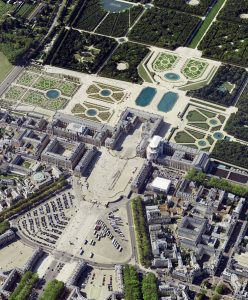WASHINTON, D.C., USA — Hexagon’s Geosystems division announced today Aero Photo Europe Investigation (APEI), an international aerial survey firm with headquarters in Moulins, France, has become the first customer to purchase the Leica CityMapper-2 oblique imaging and LiDAR hybrid airborne sensor.

International aerial survey firm APEI is the first to purchase the Leica CityMapper-2 to capture imagery like this of Versailles Castle, France.
With the CityMapper-2, APEI expands its business to the rapidly growing smart city market, which today requires more detailed and more accurate data on larger areas in fast-changing urban environments.
APEI is currently operating a CityMapper that incorporates the latest-generation linear-mode LiDAR from the Leica TerrainMapper. With the higher performance 2 MHz pulse rate LiDAR scanner, the firm has benefitted from significant operational advantages, such as an increased data collection rate versus flying height. This performance improvement enables flying larger swaths for any given point density and to achieve more efficient flight planning and even point distribution for all flying heights from 300 – 5,500 m AGL with up to 35 pulses in the air and with no range gate limitations.
During the recent winter season, APEI carried out several LiDAR projects. For example, the firm captured Haut-Rhin, France, over an area of 2,350 km² with a ground point density of 10 pts/m². APEI has a long history with the CityMapper as the first to fly the original CityMapper during the product development process.
“We have established a solid relationship of trust with our customers, and they know they can count on us to carry out their missions. Due to this relationship, we have never hesitated to invest heavily in all the materials necessary to maintain our skills and address new market demands, and our purchase of the CityMapper-2 is another major step,” said APEI CEO Bruno Callabat. “With this investment, we will be able to offer imagery and LiDAR data for 3D urban modeling, a keen interest of our customers. Moreover, we firmly believe that the combination of an ultra-efficient LiDAR with circular pattern with the latest-generation oblique sensor will allow us to offer final products of unrivaled quality. Last but not least, being able to independently use either oblique imagery or LiDAR with the CityMapper-2 will allow us to increase our offerings to our customers”
High-performance urban mapping sensor to create digital twins
Increasing significantly productivity and data quality for the creation of digital twins of cities and metro areas, the CityMapper-2 now offers a newly developed optical system incorporating two nadir (RGB & NIR) and four oblique 150 MP metric camera, using CMOS technology and equipped with Leica Geosystems’ Forward Motion Compensation (FMC) technology, allowing the capture of high-quality imagery even in difficult lighting conditions with no reduction in efficiency. Furthermore, the LiDAR sensor’s pulse repetition frequency has been increased to 2 MHz and features gateless Multiple-Pulses in the Air (MPiA) technology, with similar performance to the TerrainMapper, allowing the collection of point clouds in the most complex reliefs and urban environments.
“As populations grow and move into urban areas, fast-changing urban centres need to be monitored faster and more efficiently. Accurate 3D digital twins of cities build the backbone. We wanted to provide our customers and end-customers fast access to digital twins by producing the most efficient and productive method of collecting and processing data. Together with the HxMap processing workflow, the CityMapper-2 is the enabling technology for fast data updates in urban centres,” said John Welter, president of Geospatial Content Solutions, Hexagon’s Geosystems division. “With our strong working relationship with APEI, we are excited to see the innovative uses the firm will find for the CityMapper-2 and the collected data. As a firm dedicated to advancing airborne acquisition, there is no better first customer for our latest airborne sensor innovation.”
As a long-time customer of Leica Geosystems, part of Hexagon’s Geosystems division, airborne solutions, APEI has steadily upgraded its fleet with the latest innovations such as the Leica DMC III airborne imaging system in 2017 and the Leica ALS70-HP airborne LiDAR in 2015. Furthermore, since 2016, APEI has been one of the first companies in the world operating the Leica RealCity urban mapping solution, combining the CityMapper with the HxMap high-performance processing workflow for the simultaneous collection of oblique images and LiDAR point clouds for 3D urban projects, like in the cities of Bordeaux and Paris in France.